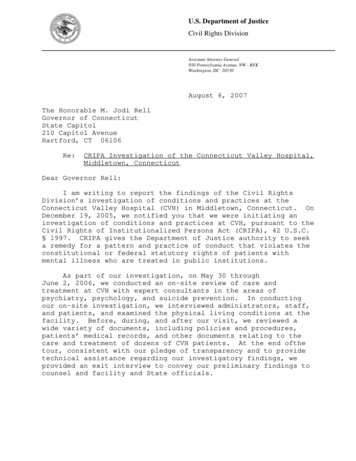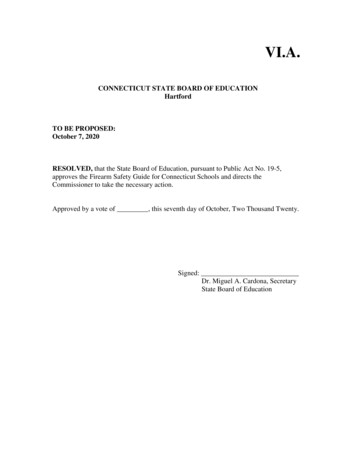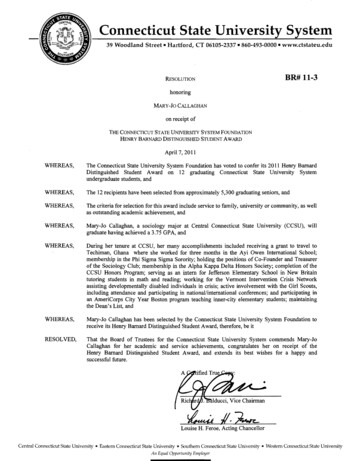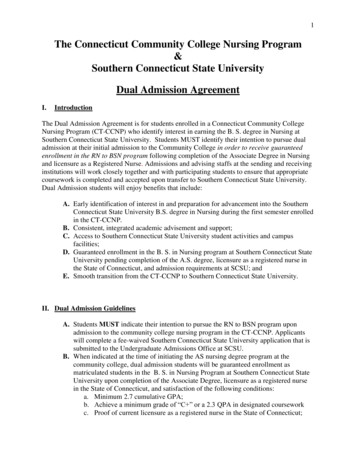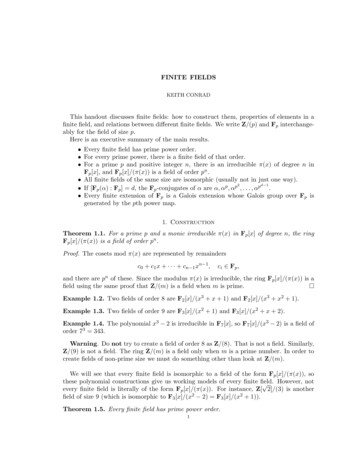
Transcription
FINITE FIELDSKEITH CONRADThis handout discusses finite fields: how to construct them, properties of elements in afinite field, and relations between different finite fields. We write Z/(p) and Fp interchangeably for the field of size p.Here is an executive summary of the main results. Every finite field has prime power order. For every prime power, there is a finite field of that order. For a prime p and positive integer n, there is an irreducible π(x) of degree n inFp [x], and Fp [x]/(π(x)) is a field of order pn . All finite fields of the same size are isomorphic (usually not in just one way).2d 1 If [Fp (α) : Fp ] d, the Fp -conjugates of α are α, αp , αp , . . . , αp . Every finite extension of Fp is a Galois extension whose Galois group over Fp isgenerated by the pth power map.1. ConstructionTheorem 1.1. For a prime p and a monic irreducible π(x) in Fp [x] of degree n, the ringFp [x]/(π(x)) is a field of order pn .Proof. The cosets mod π(x) are represented by remaindersc0 c1 x · · · cn 1 xn 1 ,ci Fp ,and there are pn of these. Since the modulus π(x) is irreducible, the ring Fp [x]/(π(x)) is afield using the same proof that Z/(m) is a field when m is prime. Example 1.2. Two fields of order 8 are F2 [x]/(x3 x 1) and F2 [x]/(x3 x2 1).Example 1.3. Two fields of order 9 are F3 [x]/(x2 1) and F3 [x]/(x2 x 2).Example 1.4. The polynomial x3 2 is irreducible in F7 [x], so F7 [x]/(x3 2) is a field oforder 73 343.Warning. Do not try to create a field of order 8 as Z/(8). That is not a field. Similarly,Z/(9) is not a field. The ring Z/(m) is a field only when m is a prime number. In order tocreate fields of non-prime size we must do something other than look at Z/(m).We will see that every finite field is isomorphic to a field of the form Fp [x]/(π(x)), sothese polynomial constructions give us working models of every finite field.However, not every finite field is literally of the form Fp [x]/(π(x)). For instance, Z[ 2]/(3) is anotherfield of size 9 (which is isomorphic to F3 [x]/(x2 2) F3 [x]/(x2 1)).Theorem 1.5. Every finite field has prime power order.1
2KEITH CONRADProof. For each commutative ring R there is a unique ring homomorphism Z R, where if m 0,1 1 {z· · · 1}, m timesm 7 (1 1 {z· · · 1}), if m 0. m timesWe apply this to the case when R F is a finite field. The kernel of Z F is nonzerosince Z is infinite and F is finite. Write the kernel as (m) mZ for an integer m 0, soZ/(m) embeds as a subring of F . A subring of a field is a domain, so m has to be a primenumber, say m p. Therefore there is an embedding Z/(p) , F . Viewing F as a vectorspace over Z/(p), it is finite-dimensional since F is finite. Letting n dimZ/(p) (F ) andpicking a basis {e1 , . . . , en } for F over Z/(p), elements of F can be written uniquely asc1 e1 · · · cn en , ci Z/(p).Each coefficient has p choices, so F pn . Lemma 1.6. If F is a finite field, the group F is cyclic.Proof. Let q F , so F q 1. Let m be the maximal order of the elements of thegroup F , so m (q 1) by Lagrange’s theorem. We will show m q 1.It is a theorem from group theory (see the appendix) that in a finite abelian group, allorders of elements divide the maximal order of the elements1, so every t in F satisfiestm 1. Therefore all numbers in F are roots of the polynomial xm 1. The number ofroots of a polynomial over a field is at most the degree of the polynomial, so q 1 m.Since m is the order of some element in F , we have m (q 1), so m q 1. Thereforem q 1, so some element of F has order q 1. Example 1.7. In F : F3 [x]/(x2 1), there are 8 nonzero elements. The powers of x arex, x2 1 2, x3 2x, x4 2x2 2 1,so x does not generate F . But x 1 does: its powers are in the table below.k12345678kx x 1 2x 2x 1 2 2x 2 x x 2 1Example 1.8. For prime p, (Z/(p)) is cyclic: (Z/(p)) {a, a2 , . . . , ap 1 mod p} forsome a 6 0 mod p. A constructive proof of this, using the prime factorization of p 1, is inSection 6 of cyclicmodp.pdf.Remark 1.9. For a finite field F , the multiplicative group F is cyclic but the additivegroup of F is usually not cyclic. When F contains Fp , since p 0 in Fp every nonzeroelement of F has additive order p, so F is not additively cyclic unless F is prime.Theorem 1.10. Every finite field is isomorphic to Fp [x]/(π(x)) for some prime p and somemonic irreducible π(x) in Fp [x].Proof. Let F be a finite field. By Theorem 1.5, F has order pn for some prime p and positiveinteger n, and there is a field embedding Fp , F .The group F is cyclic by Lemma 1.6. Let γ be a generator of F . Evaluation at γ,namely f (x) 7 f (γ), is a ring homomorphism evγ : Fp [x] F that fixes Fp . Since every1In a nonabelian finite group, all orders of elements don’t have to divide the maximal order, e.g., in S3the orders of elements are 1, 2, and 3.
FINITE FIELDS3number in F is 0 or a power of γ, evγ is onto (0 evγ (0) and γ r evγ (xr ) for all r 0).Therefore Fp [x]/ ker evγ F . Since F is a field, the kernel of evγ is a maximal ideal inFp [x], so ker evγ (π(x)) for a monic irreducible π(x) in Fp [x]. Fields of size 9 that are of the form Fp [x]/(π(x)) need p 3 and deg π(x) 2. Themonic irreducible quadratics in F3 [x] are x2 1, x2 x 2, and x2 2x 2. InF3 [x]/(x2 1),F3 [x]/(x2 x 2),F3 [x]/(x2 2x 2),x does not generate the nonzero elements in the first field but it generates the nonzeroelements in the second and third fields. So although F3 [x]/(x2 1) is the simplest choiceamong these three examples, it’s not the one that would come out of the proof of Theorem1.10 when we look for a model of fields of order 9 as F3 [x]/(π(x)).Theorem 1.10 does not assure us that a field of each prime power order exists. It only tellsus that if a field of order pn exists then it is isomorphic to Fp [x]/(π(x)) for some irreducibleπ(x) of degree n in Fp [x]. Why is there an irreducible of each degree in Fp [x]? In the nextsection we will show a field of each prime power order does exist and there is an irreduciblein Fp [x] of each positive degree.2. Finite fields as splitting fieldsEach finite field is a splitting field of a polynomial depending only on the field’s size.nLemma 2.1. A field of prime power order pn is a splitting field over Fp of xp x.Proof. Let F be a field of order pn . From the proof of Theorem 1.5, F contains a subfieldisomorphic to Z/(p) Fp . Explicitly, the subring of F generated by 1 is a field of order p.nnEvery t F satisfies tp t: if t 6 0 then tp 1 1 since F F {0} is a multiplicativengroup of order pn 1, and then multiplying through by t gives us tp t, which is also truenpwhen t 0. The polynomial x x has every element of F as a root, so F is a splittingnfield of xp x over the field Fp . Theorem 2.2. For every prime power pn , a field of order pn exists.Proof. Taking our cue from the statement of Lemma 2.1, let F be a field extension of Fpnover which xp x splits completely. General theorems from field theory guarantee therenis such a field. Inside F , the roots of xp x form the setnS {t F : tp t}.nnnThis set has size pn since the polynomial xp x is separable: (xp x)0 pn xp 1 1 1nsince p 0 in F , so xp x has no roots in common with its derivative. It splits completelyover F and has degree pn , so it has pn roots in F .We will show S is a subfield of F . It contains 1 and is easily closed under multiplicationand (for nonzero solutions) inversion. It remains to show S is an additive group. Sincep 0 in F , (a b)p ap bp for all a and b in F (the intermediateterms in (a b)p coming pfrom the binomial theorem have integral coefficients k , which are all multiples of p andnthus vanish in F ). Therefore the pth power map t 7 tp on F is additive. The map t 7 tpis also additive since it’s the n-fold composite of t 7 tp with itself and the composition
4KEITH CONRADof homomorphisms is a homomorphism.2 The fixed points of an additive map are a groupunder addition, so S is a group under addition. Therefore S is a field of order pn . Corollary 2.3. For every prime p and positive integer n, there is a monic irreducibleof degree n in Fp [x], and moreover π(x) can be chosen so that every nonzero element ofFp [x]/(π(x)) is congruent to a power of x.Proof. By Theorem 2.2, a field F of order pn exists. By Theorem 1.10, the existence ofan abstract field of order pn implies the existence of a monic irreducible π(x) in Fp [x] ofdegree n, and from the proof of Theorem 1.10 x mod π(x) generates the nonzero elementsof Fp [x]/(π(x)) since the isomorphism identifies x mod π(x) with a generator of F . Appreciate the order in the logic behind Theorem 2.2 and its corollary: to show we canconstruct a field of order pn as Fp [x]/(π(x)) where deg π(x) n, the way we showed a π(x)of degree n exists is by first constructing an abstract field F of order pn (using a splittingfield construction) and then proving F can be made isomorphic to an Fp [x]/(π(x)).Remark 2.4. There is no formula for an irreducible of each degree in Fp [x]. Binomialpolynomials xn a are reducible when p n. Trinomials xn axk b with a, b F p and0 k n are often irreducible, but in some degrees they are all reducible: that occurs inF2 [x] in degrees 8 and 13, in F3 [x] in degrees 49 and 57, in F5 [x] in degrees 35 and 70, andin F7 [x] in degrees 124 and 163.nTheorem 2.5. Each irreducible π(x) in Fp [x] of degree n divides xp x and is separable.nProof. The field Fp [x]/(π(x)) has order pn , so tp t for all t in Fp [x]/(π(x)) (see the proofnnof Lemma 2.1). In particular, xp x mod π(x), so π(x) (xp x) in Fp [x]. We saw in thenproof of Theorem 2.2 that xp x is separable in Fp [x], so its factor π(x) is separable. nExample 2.6. In F2 [x], the irreducible factorization of x2 x for n 1, 2, 3, 4 is as follows.x2 x x(x 1),x4 x x(x 1)(x2 x 1),x8 x x(x 1)(x3 x 1)(x3 x2 1),x16 x x(x 1)(x2 x 1)(x4 x 1)(x4 x3 1)(x4 x3 x2 x 1).nIn each case the irreducibles of degree n appear in the factorization of x2 x, whichTheorem 2.5 guarantees must happen. That each factor occurs just once reflects the factnnthat xp x is separable. There are irreducible factors of xp x with degree less than n,nif n 1; the irreducible factors of xp x in Fp [x] turn out (Lemma 3.3 below) to be theirreducibles in Fp [x] of degree dividing n and each such factor appears once.We write Fpn for a finite field of order pn . Features to keep in mind are it contains a unique subfield isomorphic to Fp (namely the subfield generated by 1), [Fpn : Fp ] n by the proof of Theorem 1.5,n it is a splitting field of xp x over Fp by the proof of Theorem 2.2.pnk2Alternatively, additivity of t 7 tpn follows from the binomial coefficientsn a a 1pk1 k p 1. In general b b a b 1 for 1 b a, so k pnis divisible by pn and the first factor k is not divisible bykknn 1 pn pk 1n np , so pk is being divisible by p forwhen 1 k pn 1. Thusdivisible by p.
FINITE FIELDS5nAlthough xp x has degree pn , its splitting field over Fp has degree n, not pn . That is notnweird, because xp x is reducible (see Example 2.6). The situation is similar to xm 1,which for m 1 is reducible and its splitting field over Q has degree less than m.Theorem 2.7. All finite fields of the same size are isomorphic to each other.Proof. A finite field has prime power size, say pn . By Lemma 2.1, it is a splitting field ofnxp x over Fp . Two splitting fields of a polynomial over Fp are isomorphic (that is, thereis a bijective homomorphism between them), so fields of order pn are isomorphic. For finite groups and finite rings, having the same size does not usually imply isomorphism. For instance, Z/(4) and Z/(2) Z/(2) have order 4 and they are nonisomorphic asadditive groups (one is cyclic and the other is not) and as commutative rings (one has anonzero element squaring to 0 and other does not).Theorem 2.8. A subfield of Fpn has order pd where d n, and there is one such subfieldfor each d.Proof. Let F be a field with Fp F Fpn . Set d [F : Fp ], so d divides [Fpn : Fp ] n.We will describe F in a way that only depends on F pd .ddSince F has order pd 1, for all t F we have tp 1 1, so tp t, and that holdsdeven for t 0. The polynomial xp x has at most pd roots in Fpn , and since F is a set ofpd different roots of it,dF {t Fpn : tp t}.This shows there is at most one subfield of order pd in Fpn , since the right side is completelydetermined as a subset of Fpn from knowing pd .To prove for each d dividing n there is a subfield of Fpn with order pd , we turn thingsdaround and consider {t Fpn : tp t}. It is a field by the same proof that S is a field indthe proof of Theorem 2.2. To show its size is pd we want to show xp x has pd roots indnFpn . We’ll do this in two ways. First, d n (pd 1) (pn 1) xp 1 1 xp 1 1 dnnxp x xp x, so since xp x splits with distinct roots in Fpn [x] so does its factordnxp x. Second, d n (pd 1) (pn 1) and F pn is cyclic of order p 1, so it containsddpd 1 solutions to tp 1 1. Along with 0 we get pd solutions in Fpn to tp t. Example 2.9. In the diagram below are the subfields of Fp8 and Fp12 .Fp12Fp 832Fp42Fp22Fp2Fp4Fp 6223Fp 2Fp 323FpThese resemble the lattice of divisors of 8 and divisors of 12. Even though pk divides p12for k 12, that does not mean Fpk Fp12 for k 12: the only Fpk that can lie in Fp12
6KEITH CONRADare those for which [Fpk : Fp ] divides [Fp12 : Fp ], which means k divides 12. Theorem 2.8kguarantees when k 12 that elements of Fpk are solutions to tp t in Fp12 .Example 2.10. One field of order 16 24 is F2 [x]/(x4 x 1). All elements satisfy t16 t.The solutions to t2 t are the subfield {0, 1} of order 2 and the solutions to t4 t are thesubfield {0, 1, x2 x, x2 x 1} of order 4.3. Describing Fp -conjugatesTwo elements in a finite field are called Fp -conjugate if they share the same minimalpolynomial over Fp . We will show, after some lemmas about polynomials over Fp , that allFp -conjugates can be obtained from each other by successively taking pth powers. A precisestatement is in Theorem 3.4.mmLemma 3.1. For every f (x) Fp [x], f (x)p f (xp ) for m 0.Proof. The case m 0 is obvious, and it suffices by induction to do the case m 1.In a ring of characteristic p, the pth power map is additive. For a polynomial f (x) cn xn · · · c1 x c0 in the ring Fp [x], we havef (x)p (cn xn · · · c1 x c0 )p cpn xpn · · · cp1 xp cp0 .Every c Fp satisfies cp c, sof (x)p cn xpn · · · c1 xp c0 f (xp ). Example 3.2. In F5 [x],(2x4 x2 3)5 2x20 x10 3.nLemma 3.3. For irreducible π(x) in Fp [x] of degree d and n 0, π(x) (xp x) d n.dProof. To prove ( ), write n kd. Starting with xp x mod π(x) (from Theorem 2.5)and applying the pd -th power to both sides k times, we obtaind2dx xp xp · · · xpkdmod π(x).n(xpThus π(x) x).We will prove ( ) in two ways.nFor the first proof we will work in a field Fpn of order pn . Since xp x splits completelynin Fpn [x] and π(x) is a factor of xp x, π(x) splits completely in Fpn [x], so π(x) has aroot in Fpn , say α. Then Fpn has the subfield Fp (α), which has order pd . Since [Fp (α) : Fp ]divides [Fpn : Fp ], we get d n.The second proof uses congruences, not splitting fields. Our divisibility hypothesis says(3.1)nxp x mod π(x)and we want to conclude d n. Write n dq r with 0 r d. We will show r 0.ndq rdqrdqnrWe have xp xp p (xp )p . By ( ), xp x mod π, so xp xp mod π. Thus,by (3.1),(3.2)rxp x mod π(x).This tells us that one particular element of Fp [x]/(π(x)), the class of x, is equal to itsown pr -th power. Let’s extend this property to all elements of Fp [x]/(π(x)). For everyrrf (x) Fp [x], f (x)p f (xp ) by Lemma 3.1. Combining with (3.2),rf (x)p f (x) mod π(x).
FINITE FIELDS7Therefore, in Fp [x]/(π(x)), the class of f (x) is equal to its own pr -th power. As f (x) isra general polynomial in Fp [x], we have proved every t Fp [x]/(π(x)) satisfies tp t (inFp [x]/(π(x))). Recall r is the remainder when n is divided by d.rConsider now the polynomial X p X. When r 0, this is a nonzero polynomial withdegree pr . We have found pd different roots of this polynomial in the field Fp [x]/(π(x)),namely every element. Therefore pd pr , so d r. But, recalling where r came from,r d. This is a contradiction, so r 0. That proves d n. Theorem 3.4. Let π(x) be irreducible in Fp [x] with degree d and E Fp be a field in2d 1which π(x) has a root, say α. Then π(x) has roots α, αp , αp , . . . , αp . These d roots areijdistinct; more precisely, when i and j are nonnegative, αp αp i j mod d.Proof. Since π(x)p π(xp ) by Lemma 3.1, we see αp is also a root of π(x), and likewise23dαp , αp , and so on by iteration. Once we reach αp we have cycled back to the start:ddαp α by Lemma 3.3: xp x π(x)g(x) for some g(x) Fp [x], and substitute α for x.ijNow we will show αp αp i j mod d, where i, j 0. We may suppose withoutloss of generality that i j, say j i k with k 0. Theniαp αpjiki αp (αp )pkii (αp )p αp 0ki (αp α)p 0k αp α 0.Since π(x) is irreducible in Fp [x] and has α as a root, π(x) up to scaling is the minimalpolynomial of α over Fp . So π(x) divides each polynomial in Fp [x] vanishing at α. Thusiαp αpjk π(x) (xp x) in Fp [x] d k by Lemma 3.3 i j mod d.Since 0, 1, . . . , d 1 are not congruent modulo d, the above equivalence tells us that the rootsd 1α, αp , . . . , αpare distinct. Since π(x) has at most d deg π roots in a field, Theorem 3.4d 1tells us the d roots α, αp , . . . , αpare a complete set of roots of π(x). Example 3.5. The polynomial x3 x2 1 is irreducible in F2 [x] since it’s a cubic withouta root in F2 . In the field F F2 [y]/(y 3 y 2 1), x3 x2 1 has a root y (we should writethis as a coset, like y, but we’ll use y). Its other roots in F are y 2 and y 4 .Since y 3 y 2 1 0 in F , we have y 3 y 2 1 (since 1 1), so y 4 y 3 y 2(y 1) y y 2 y 1. Therefore, the roots of x3 x2 1 in F are y, y 2 , and y 2 y 1.Example 3.6. The polynomial x3 2 is irreducible in F7 [x]. In the field F F7 [y]/(y 3 2),x3 2 has roots y, y 7 , and y 49 . Since y 3 2 in F , y 7 (y 3 )2 y 4y and y 49 (y 7 )7 (4y)7 47 y 7 4 · 4y 2y. So the roots of x3 2 in F are y, 2y, and 4y. This is like theformula for roots of x3 2 in C: 3 2, ω 3 2, and ω 2 3 2. In characteristic 7, the numbers 2and 4 are nontrivial cube roots of unity, so they are like ω and ω 2 in C.Theorem 3.4 says if π(x) Fp [x] is irreducible and α is a rootof π(x) then Fp (α) is a 3splitting field of π(x) over Fp . This is quite different over Q: Q( 2) is not a splitting fieldof x3 2 over Q. Here is an even more striking contrast between Q and Fp .
8KEITH CONRADCorollary 3.7. Let π1 (x) and π2 (x) be irreducible of the same degree in Fp [x] and α be aroot of π1 (x). Then Fp (α) is a splitting field of π2 (x) over Fp .nProof. Set F Fp (α) Fp [x]/(π1 (x)), so F has order pn . The polynomial xp x splitsncompletely over F (Lemma 2.1), and π2 (x) (xp x) in Fp [x] (Theorem 2.5), so π2 (x) splitscompletely over F . Letting β be a root of π2 (x) in F , Fp (β) has order pn so F Fp (β).Theorem 3.4 implies that F is a splitting field over π2 (x) over Fp . Example 3.8. Both x3 2 and x3 x2 6x 5 are irreducible over F7 . Let α be a rootof x3 2 over F7 . In F7 (α), x3 x2 6x 5 must have 3 roots. One root is α2 α 2(found by a search). Using the relation α3 2, the other two roots of x3 x2 6x 5 inF7 (α) are (α2 α 2)7 2α2 4α 2 and (α2 α 2)49 4α2 2α 2.4. Galois groupsnSince Fpn is the splitting field over Fp of xp x, which is separable, Fpn /Fp is Galois.It is a fundamental feature that the Galois group is cyclic, with a canonical generator.Theorem 4.1. The p-th power map ϕp : t 7 tp on Fpn generates Gal(Fpn /Fp ).Proof. Each a Fp satisfies ap a, so the function ϕp : Fpn Fpn fixes Fp pointwise.Also ϕp is a field homomorphism and it is injective (all field homomorphisms are injective),so ϕp is surjective since Fpn is finite. Therefore ϕp Gal(Fpn /Fp ).The size of Gal(Fpn /Fp ) is [Fpn : Fp ] n. We will show ϕp has order n in this group, sorit generates the Galois group. For r 1 and t Fpn , ϕrp (t) tp . If ϕrp is the identity thenrrrtp t for all t Fpn , which can be rewritten as tp t 0. The polynomial xp x hasdegree pr (since r 1), so it has at most pr roots in Fpn . Thus pn pr , so n r. Hence ϕphas order at least n in Gal(Fpn /Fp ), a group of order n, so ϕp generates the Galois group:every element of Gal(Fpn /Fp ) is an iterate of ϕp . Galois theory makes Theorem 2.8 follow from Theorem 4.1: an extension with a cyclicGalois group has its lattice of intermediate fields resemble the lattice of subgroups of a cyclicgroup, with the unique subfield of degree d over Fp corresponding to the unique subgroupof the Galois group with index d. In the diagram below are subfields of Fp12 on the left andcorresponding subgroups of Gal(Fp12 /Fp ) hϕp i Z/(12) on the right.hϕ12p iFp1232Fp432hϕ4p iFp 6hϕ6p i22232Fp 2Fp 323Fp3hϕ2p ihϕ3p i23hϕp iTheorem 3.4 can be explained in a second, shorter, way as a corollary of Theorem 4.1and we also get part of Theorem 2.5.
FINITE FIELDS9Corollary 4.2. If π(x) Fp [x] is irreducible with degree d then it is separable and if α is2d 1one of its roots in some extension field of Fp then its full set of roots is α, αp , αp , . . . , αp .Proof. We have seen already that a finite field of p-power order is Galois over Fp . The fieldFp (α) is finite, so it is Galois over Fp and the roots of π(x) in Fp (α) can be obtained fromα by applying Gal(Fp (α)/Fp ) to this root. Since the Galois group is generated by the p-th2dpower map, the roots of π(x) are α, αp , αp , . . . . Once we reach αp we have cycled backdto the start: αp α since Fp (α) Fp [x]/(π(x)) has order pd and all elements in a fieldd2of order pd satisfy tp t. Therefore the list α, αp , αp , . . . of all possible roots of π(x) isd 1α, αp , . . . , αp . Why are they all distinct?Since Fp (α)/Fp is Galois and π(x) is irreducible over Fp with a root α in Fp (α), π(x) isseparable over Fp and splits completely over Fp (α). Therefore π(x) has d different roots ind 1Fp (α), so the list α, αp , . . . , αphas to consist of distinct numbers. The p-th power map on Fpn is called the Frobenius automorphism. This function, whoseformula doesn’t involve n, generates Gal(Fpn /Fp ) for all n 1.Let’s compute some concrete Galois groups over Fp .Example 4.3. The polynomial x3 x2 1 is irreducible over F2 . If α is a root of it over F2then F2 (α)/F2 is a cubic Galois extension and Gal(F2 (α)/F2 ) {x 7 x, x 7 x2 , x 7 x4 }.The second element is the Frobenius automorphism ϕ2 and the third is ϕ22 . By Example3.5 we have α4 α2 α 1, so we can make a table below describing each automorphism’seffect on α in the F2 -basis {1, α, α2 }.id. ϕ2ϕ22σσ(α)α α2 α2 α 1Example 4.4. The polynomial x2 1 is irreducible over F3 . Let α be a root, so F3 (α)/F3is a Galois extension of degree 2. Its Galois group is {x 7 x, x 7 x3 }. A basis of F3 (α)over F3 is {1, α} and the Frobenius automorphism ϕ3 on a typical element ϕ3 (a bα) (a bα)3 a bα3 since a3 a and b3 b for a, b F3 .The two roots of x2 1 are α and α3 , but they are also α and α, so α3 α. Thatcan be seen by a direct calculation as well: α3 (α2 )α α. So we could also describethe Frobenius automorphism in Gal(F3 (α)/F3 ) by ϕ3 (a bα) a bα.Example 4.5. The polynomial x3 2 is irreducible over F7 . If α is a root of it thenF7 (α)/F7 is a Galois extension and Gal(F7 (α)/F7 ) {x 7 x, x 7 x7 , x 7 x49 }. Fromthe work in Example 3.6, α7 4α and α49 2α. Therefore we can also describe theautomorphisms in Gal(F7 (α)/F7 ) by their effect on α as in the table below.σid. ϕ7 ϕ27σ(α)α 4α 2α5. General finite base fieldsIn addition to working with finite fields as extensions of Fp , we can fix a finite field Fqof possibly nonprime size (e.g., q 4 or 27) and look at finite extensions of Fq . Whileevery a Fp satisfies ap a, in Fq every element a satisfies aq a. This follows from theq 1 1proof of Lemma 2.1, but we give the proof again since it’s short: if a F q then aqby Lagrange’s theorem, so a a, and this last equation is satisfied by 0 too. In a finiteextension F/Fq , the qth power map F F is an automorphism (it is an iterate of the pth
10KEITH CONRADpower automorphism of F , where p is the prime that q is a power of) and the subset of Ffixed by the qth power map is Fq : the equation aq a has at most q solutions in F and Fqis a set of q solutions inside F . Watch out: when q is a power of the prime p then Fq hascharacteristic p, not characteristic q (unless q p). No field has a composite characteristic.Since p 0 in Fq , also q 0 in Fq , so that aspect looks the same; it’s just that q is not thesmallest positive integer vanishing in Fq if q p.Here are analogues over Fq of results we proved over Fp . Proofs are left to the reader.Theorem 5.1. For every positive integer n, there is a monic irreducible of degree n innFq [x], and all of them divide xq x, which is separable. In particular, every irreducible inFq [x] is separable.Theorem 5.2. Between Fq and Fqn every intermediate field has order q d where d n.Conversely, for each d dividing n there is a unique field between Fq and Fqn of order q d ,dwhich is {t Fqn : tq t}.mmLemma 5.3. For every f (x) Fq [x], f (x)q f (xq ) for m 0.nLemma 5.4. Let π(x) be irreducible of degree d in Fq [x]. For n 0, π(x) (xq x) d n.Theorem 5.5. Let π(x) be irreducible in Fq [x] with degree d and E Fq be a field in2d 1which π(x) has a root, say α. Then π(x) has roots α, αq , αq , . . . , αq . These d roots areijdistinct; more precisely, when i and j are nonnegative, αq αq i j mod d.Theorem 5.6. For every integer n 1, Fqn /Fq is a Galois extension and Gal(Fqn /Fq ) iscyclic with generator the q-th power map ϕq : t 7 tq .6. ApplicationsFinite fields are important in both pure and applied math. Here are some examples.(1) Number theory. Many problems in Z are studied by reducing mod p, which putsus in the finite fields Z/(p). In every finite extension K of Q is a ring OK playing arole analogous to that of Z in Q. (For example, when K Q( 2), OK Z[ 2].)Problems in OK can often be reduced to working in the fields OK /m where m is amaximal ideal. Every OK /m is a finite field and often is not of prime order.(2) Group theory. Most nonabelian finite simple groups besides alternating groupsAn (n 5) come from matrix groups over finite fields, and their construction isanalogous to that of simple Lie groups over C. Galois himself created finite fields ofnonprime order in order to describe primitive solvable permutation groups [1, Sect.14.3], [2], [6, p. 344].(3) Combinatorics. An important theme in combinatorics is q-analogues, which arealgebraic expressions in a variable q that become classical objects when q 1, orwhen q 1. For example, the q-binomial coefficient is n(q n 1)(q n q) · · · (q n q k 1 ) k,k q(q 1)(q k q) · · · (q k q k 1 )which for n k is a polynomialin q with integer coefficients. When q 1 this has the value nk . While nk counts the number of k-element subsets of a finite set, whenq is a prime power the number nk q counts the number of k-dimensional subspaces
FINITE FIELDS11of Fnq . Identities involving q-binomial coefficients can be proved by checking themwhen q runs through prime powers, using linear algebra over the fields Fq .(4) Coding theory. This is the study of clear communication over noisy channels.Messages sent back to earth by NASA space probes, information engraved on aDVD, and signals allowing many mobile phone conversations on the same channelare created using codes where the code words are coefficients of a polynomial overa finite field.(5) Cryptography. This is the study of secret communication. The usual way information is stored securely on an ATM card involves elliptic curves over finite fields.The lesson from the last two examples is that even people who say “math sucks” areusing finite fields every day without realizing it.37. HistoryFields of prime order, namely Z/(p), were studied by many of the early number theoristssuch as Fermat, Euler, Lagrange, Legendre, and Gauss. The first mathematician to publisha paper on finite fields of non-prime order was Galois in 1830. Gauss had developed thetheory of finite fields earlier [3], discovering such critical properties as Theorems 2.8 andCorollary 4.2, but this was discovered only after his death in 1855 and published in 1863without having much influence. Galois constructed finite fields as Fp (α) where α is theroot of an irreducible polynomial π(x) in Fp [x] while Gauss worked with finite fields asFp [x]/(π(x)). Galois wrote that there is an irreducible in Fp [x] of every degree but he didnot give a proof.In 1893, at the International Mathematical Congress in Chicago, E. H. Moore provedthat every finite field is isomorphic to a field of the form Fp [x]/(π(x)), a theorem whichhe described with the comment [7, p. 211] “This interesting result I have not seen statedelsewhere.” Moore was the first person to use the word field in its algebraic sense, althoughhe treated it as a synonym for the German term endlicher Körper, which means finite field[7, p. 208]. So to Moore, a field meant what we’d call a finite field. He called a
2. Finite fields as splitting fields Each nite eld is a splitting eld of a polynomial depending only on the eld's size. Lemma 2.1. A eld of prime power order pn is a splitting eld over F p of xp n x. Proof. Let F be a eld of order pn. From the proof of Theorem1.5, F contains a sub eld isomorphic to Z (p) F p. Explicitly, the subring of .
